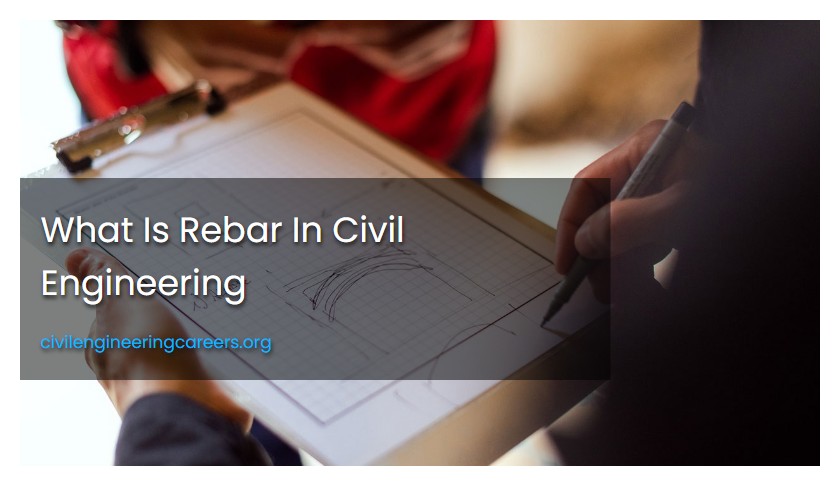What Is Rebar In Civil Engineering

Rebar is derived from reinforcing bar and refers to the use of steel rods with ridges to reinforce concrete. This is because concrete is strong in compression but weak in tension, and can become damaged when tensile forces are applied, often resulting in cracks.
Rebar is a shortened form of steel reinforcing bar used to enhance the tensile strength of concrete. It is utilized to reinforce concrete structures that are weak in tension to improve their performance under loaded conditions.
What is rebar used for?
Rebar is used as a tension device in reinforced concrete and reinforced masonry structures to strengthen and aid the concrete under tension.
What are the different types of steel rebar?
There are various types of steel rebar, but the most common is carbon steel rebar. Other types include epoxy-coated rebar, galvanized rebar, and stainless steel rebar.
What is rebar deformation?
Rebar deformation refers to the surface of reinforcing steel bars being altered to include ribs, lugs, or indentations to enhance adhesion with concrete and prevent slippage.
Is rebar stronger than concrete?
Rebar significantly increases the tensile strength of a structure and is often surface-deformed to promote better bonding with concrete. However, it cannot be said that rebar is stronger than concrete.
There are various types of rebars used in construction. Carbon steel rebars, also known as black rebars, are the most common type. Welded wire fabric, sheet-metal reinforcing bars, epoxy-coated rebars, European rebars, stainless steel rebars, and galvanized rebars are the other types of rebars used in construction.
What is the best rebar grade?
Fe415 is considered the best rebar grade due to its superior qualities like ductility, yield strength, ultimate tensile strength, elongation, corrosion resistance, and weldability. It is widely recognized as the true rebar grade, despite other higher-grade variants, due to its exceptional properties.
Is stainless steel rebar corrosive resistant?
Stainless steel rebar is highly resistant to corrosion and damage compared to other types of rebar, and it can be bent in the field.
Rebar is deployed as a reinforcing mechanism in concrete and masonry structures to enhance their strength and stability against tension. It comprises steel bars placed within the construction material, primarily to withstand immense pressure and tension.
Rebar is a type of steel bar used to reinforce concrete and increase its tensile strength.
What is the difference between steel reinforced bar and rebar?
Reinforcing bar or rebar is a type of steel bar commonly used in construction as a tensioning device to strengthen concrete and other structures. There is no difference between steel reinforced bar and rebar as they both refer to the same product.
What are reinforcing steel bars used for?
Reinforcing steel bars are used to help concrete withstand tension forces and prevent cracking. They are necessary to make concrete stronger and durable.
The combination of rebar and concrete results in increased strength due to their symbiotic relationship.
Rebar often has a surface with deformations such as ribs, lugs or indentations to improve its bond with concrete and decrease slippage. Carbon steel is the most prevalent material for rebar, comprising of hot-rolled round bars with deformation patterns.
What are rebars used for?
Rebars are used for reinforcing concrete structures to increase their load-bearing capacity and prevent them from cracking or breaking under stress.
What are deformed rebars?
Deformed rebars are steel bars with ridges, bumps, or other deformations added to their surface to improve their bonding with concrete and provide increased tensile strength. Their low carbon content also makes them suitable for welding.
What are the deformation requirements for steel bar reinforcing?
US-standard product specifications for steel bar reinforcing, such as ASTM A615 and ASTM A706, contain deformation requirements regarding lug spacing and height. These requirements dictate how the steel bar should be shaped in order to meet industry standards. Alternatively, fibre-reinforced plastic rebar is an option for high-corrosion environments and can come in various forms, including spirals, rods, and meshes.
What affects the bond strength of rebar?
The bond strength between the reinforcing bar and the concrete can be affected by various factors, such as scale, rust, oil, and mud that can accumulate on the rebar surface. Scale, in particular, is a material that forms during bar manufacturing due to the cooling of hot metal.





